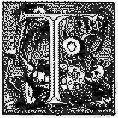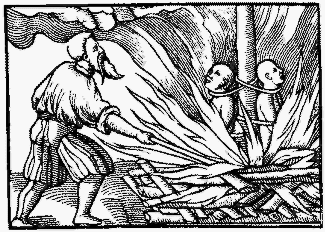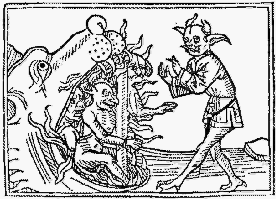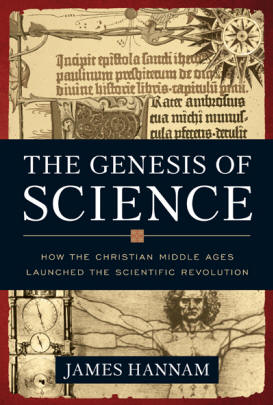Frequently Asked Questions on the Inquisition
 he
following FAQ is a result of my academic work on science in the Middle Ages and
early modern witch trials. The inquisition plays a part in both these subjects
and appears up in many more areas that interest me. Given the internet's
terrible dearth of useful information on this subject, and the large
preponderance of fantastical myths or Catholic apologetics, I thought it worth
bringing together what I had discovered and adding a short bibliography of
recent scholarship at the end. I hope the result is helpful for both the curious
and to students looking for a brief but reliable guide.
he
following FAQ is a result of my academic work on science in the Middle Ages and
early modern witch trials. The inquisition plays a part in both these subjects
and appears up in many more areas that interest me. Given the internet's
terrible dearth of useful information on this subject, and the large
preponderance of fantastical myths or Catholic apologetics, I thought it worth
bringing together what I had discovered and adding a short bibliography of
recent scholarship at the end. I hope the result is helpful for both the curious
and to students looking for a brief but reliable guide.
What does 'inquisition' actually mean?
'Inquisition' is the English term for a legal process called inquisitio in Latin that originates in the first century BC. This had no particular connotations with the church or heresy and was a widely used procedure in Europe. It still forms the foundation of, for instance, the French criminal justice system. What happens is that a magistrate, usually a professional jurist, is assigned to investigate an allegation of criminality by calling for witnesses and collecting evidence. Once he has done this, he can decide whether or not there is sufficient evidence to bring a suspect to trial. The trial is conducted in the appropriate court for the crime with the magistrate usually acting as prosecutor. This differs from the Anglo/American system where crimes are investigated by the police who do not take any part in any resulting court proceedings except as witnesses.
(Source: page 441, Henry A Kelly 'Inquisition and the Prosecution of Heresy: Misconceptions and Abuses' Church History 58, 1989)
What is meant by 'The Inquisition'?
There never was a single monolithic office of 'The Inquisition' except in later legend. Instead, in the Middle Ages there were independent inquisitors who travelled around giving their support to local tribunals and occasionally acting independently. Later particular circumstances caused inquisition tribunals to be set up in Spain, Portugal, Venice, Rome, the Netherlands and elsewhere. Most of these were independent except for nominal control by the papacy. The way these local tribunals were run was culture specific and depended on their political support and the strength of competing sources of judicial control.
(Sources: page 439, Kelly; page 122, Edward Peters Inquisition California University Press, 1989)
How did inquisitions come to be used in dealing with cases of heresy?
The medieval inquisition started life in a series of papal bulls on heresy, in particular Lucius IIIs Ad abolendum of 1184 and Innocent IIIs Cum ex officii nostri of 1207. These defined the crime of heresy, imparted the duty of the church to root it out and equated it with treason against the state. It was always the case that the church was seeking to persuade rather than enforce but recognised that these efforts had failed and that stronger measures were required. Parallel to these developments the concept of inquisitio was being used widely in canon and civil cases as part of the professionalisation of law. Innocent IV formalised the procedures for all kinds of ecclesiastic enquiries as well as instituting the office of Inquisitor of Heretical Depravity.
(Sources: pages 41 - 52, Peters; for the relevant bulls in translation see the sourcebook Heresy and Authority in Medieval Europe Scolar Press, 1980)
Who were the first inquisitors?
Cases of heresy were tried before the court of the local bishop with appeal to Rome but in some areas it was felt that back up was required. Consequently, inquisitors were appointed by the pope to carry out independent investigations as a second front. The inquisitor was usually a member of one of the mendicant orders, either a Franciscan or a Dominican monk who did not have any special powers except those already enjoyed by the local bishop. However, it is likely that they held considerable moral authority as they were educated men with a mandate from Rome that would have helped ensure co-operation. The first direct commission of inquisitors that we possess is Ille humani generis, a letter of Gregory IX to a Dominican prior ordering him to send out inquisitors to deal with heresy in his area.
(Source: page 196, Heresy and Authority)
Where did the medieval inquisitors operate?
Although they travelled all over Western Europe, most of their activity was directed at Southern France and Northern Italy. Their attention was devoted to clearing up the Cathars in the aftermath of the Albigensian crusade and then hunting down the Beguins and spiritual Fransicans after these groups were condemned by Pope John XXII. Later, the Spanish Inquisition worked under the auspices of the Spanish crown and operated through out their empire. I can find no evidence for the famous story of a pair inquisitors leaving England in disgust at the lack of qualified torturers. Although the Inquisition never did operate in Britain, several Lollards were burnt in the fourteenth century and Mary I (r. 1553 - 58) burnt nearly three hundred Protestants. The last execution for heresy in England was not until 1612, while Thomas Aikenhead was hanged for blasphemy in Scotland as late as 1697.
(Source: for England see page 160, Keith Thomas Religion and the Decline of Magic Penguin, 1991)
Did the inquisitors enforce orthodoxy among academics?
The medieval universities had a great deal of freedom to police themselves and outside inquisitors were rarely involved. If an academic produced a work felt to be heterodox then he could expect it to be enquired into by his peers. If he was found guilty, his punishment was usually negligible and it might not even effect his career prospects too adversely. His book would be glossed to mention the error rather than suppressed so that it could be used as an example in future disputes. Outside authorities would only become involved in cases where the academic was trying to disseminate his ideas outside the university environment, after repeated infringements or if there was an appeal made to a higher court.
(Sources: William Courtenay 'Inquiry and Inquisition: Academic Freedom in the Medieval Universities' Church History 58, 1989; JMMH Thijssen Censure and Heresy at the University of Paris, 1200 - 1400 Philadelphia, 1998)
How often was torture used?
Inquisitors were allowed to use torture by Gregory IX who allowed free faculty of the sword against enemies of the faith subject to various restrictions (unlike secular authorities that had greater freedom in this department). It was rarely resorted to and involved whipping or beating rather than 'rack or claws and cords'. The strapido, whereby the victim is hung by the arms and dropped, is also mentioned in the fifteenth century. Cases of abuse occurred, however, and this led to procedures being tightened up.
(Source: page 445, Kelly; pages 65 and 92, Peters)
What kinds of punishments were inflicted?
Church courts of the Middle Ages had a deserved reputation for being far more lenient than their secular equivalents and this caused tension when the jurisdictions crossed. Henry II of England was particularly displeased about this in his dispute with the church that led to the murder of St Thomas á Beckett. For instance, the secular punishment for sodomy and bestiality was death right up to the nineteenth in most European countries but a church court was more likely to send the miscreant off on a pilgrimage. Records of punishments show that public confession, the wearing of a cross, pilgrimages, imprisonment and also execution were all sanctions available to the inquisitor with more mild reproofs being much the more common.
(Source: page 66, Peters)
How often was the death penalty imposed in the Middle Ages?
The death penalty was only imposed on cases of unrepentant heretics or those found guilty of relapsing. A death sentence could also be imposed in absentia when the accused had fled as it was assumed in such cases that they were unrepentant. We do not possess many figures for the numbers of burnings but some statistics are available. For instance, Bernard Gui convicted 700 over a period of ten years in Toulouse of which 40 were executed.
(Source: page 69, James B Given Inquisition and Medieval Society New York, Cornell University Press, 2001)
Why were heretics burnt?
Burning was the punishment under ancient Roman punishment for treason after
crucifixion had been abolished in the fourth century. It was consequently used by the Holy Roman Empire to deal with traitors
and heresy was widely seen as a particularly serious kind of treason. Although
the church never specifically sanctioned burning once a heretic had been
relaxed to the secular arm, it was always perfectly well aware that this would
be the result. If the heretic confessed after sentence had already been passed
then it was usually commuted to strangulation by the executioner before the pyre
was lit. In any case the victim often suffocated before the flames reached them
although a skilled executioner could prevent this if instructed. In some
jurisdictions burning was not the punishment used, for example the Venetians
drowned traitors and heretics).
century. It was consequently used by the Holy Roman Empire to deal with traitors
and heresy was widely seen as a particularly serious kind of treason. Although
the church never specifically sanctioned burning once a heretic had been
relaxed to the secular arm, it was always perfectly well aware that this would
be the result. If the heretic confessed after sentence had already been passed
then it was usually commuted to strangulation by the executioner before the pyre
was lit. In any case the victim often suffocated before the flames reached them
although a skilled executioner could prevent this if instructed. In some
jurisdictions burning was not the punishment used, for example the Venetians
drowned traitors and heretics).
(Sources: pages 67 and 117 Peters; page 190 Heresy and Authority)
Why were inquisitors so keen to get confessions?
The desire for confessions was in great part not motivated by the need for convictions for which other evidence could always be found, but rather because of what inquisitors saw as their pastoral duty. They wanted the accused to confess so that they could also receive absolution for their sins. On the other hand, unless someone was caught red handed, a confession was necessary for a capital conviction. So no matter how good the circumstantial evidence a confession was sometimes necessary for a conviction.
(Source: page 65, Peters)
Were there ever acquittals and were appeals allowed?
Contrary to popular belief, it was possible to appeal from the inquisitors tribunal and there are many cases of appeals being heard by synods or the Vatican. Some of these appeals were even successful. However, there also exist documents that forbid appeal under certain circumstances and it was not always easy to get it heard. Acquittals also occurred, sometimes with entire investigations being thrown out.
(Source: page 445, Kelly)
Why was the Spanish Inquisition founded?
Islamic Granada and much of the rest of Spain had been a comparatively tolerant place until the late Middle Ages. At that point, when the entire peninsula was ruled by Christians, resentment against Jews and Moslems grew. Most of the later fled to North Africa, but this was less of an option for Jews who found themselves subject to widespread anti-Semitism. Many converted to Christianity but this merely changed prejudice against them from religious to racial and raised the problem of those who had only pretended to convert while continuing to practice their old faith behind closed doors. The Spanish Inquisition was formed to ensure that these conversos stayed converted but swiftly moved on to other areas rather than restricting itself to converted Jews.
(Sources: page 522, Geoffrey Parker 'Some Recent Work on the Inquisition in Spain and Italy' Journal of Modern History 54:3 1982; pages 77 - 86, Peters)
Who ran the Spanish Inquisition?
The Spanish monarchy had asked the pope to set up the Inquisition but kept a firm hold on its activities. They nominated the Inquisitor General and remained personally involved as well. The first Grand Inquisitor appointed by Ferdinand and Isabella was the notorious Thomas Torquemada who was in charge from 1483 until 1498. In this period, the Inquisition was at its bloodiest with an estimated two thousand executions up to 1504. Most of the victims were conversos whose faltering allegiance to Christianity was seen as making them dangerous to the regime and who were also subject to racist anti-Semitism. In time, concern about conversos diminished and the Inquisition turned its attention to moral matters of the sort that church courts had been dealing with for centuries. Cardinal Ximenez, who was Grand Inquisitor from 1506 to 1517, instituted widespread reform to correct some of the abuses that had taken place in earlier years.
(Source: Henry Kamen The Spanish Inquisition: A Historical Revision Yale University Press, 1998)
How many were executed by the Spanish Inquisition?
By most standards, the records of the Spanish Inquisition are spectacularly good and a treasure trove for social historians as they record many details about ordinary people. Nothing like all the files have been analysed but from the third looked at so far, it seems the Inquisition, operating through out the Spanish Empire, executed about 700 people between 1540 and 1700 out of a total of 49,000 cases. It is also reckoned that they probably killed about two thousand during the first fifty years of operation when persecution against Jews and Moslems was at its most severe. This would give a total figure of around 5,000 for the entire three hundred year period of its operation.
(Source: page 526, Parker)
What was an auto de fe?
This means 'act of faith' and was the public act of repentance that those whom the Inquisition had convicted were required to make. This involved a public confession, the reading of sentence and the penitent being packed off on their pilgrimage, confinement or whatever. Those who were to be executed were then handed over to the secular wing. Their burning took place immediately and formed the climax of the event which drew huge crowds. For this reason, the auto de fe has become synonymous with the public burning of heretics.
(Source: pages 95 - 96, Peters)
When did the Spanish Inquisition end?
After about 1700 it was a feeble shadow of its former self but limped on for over another hundred years until 1835 when it was suppressed for the last time. The various other Inquisitions of Sicily, the New World and Venice disappeared in the decades around 1800, finally killed off by the Napoleonic Wars.
(Source: pages 104 and 109, Peters)
Which Inquisition tried Bruno and Galileo?
Bruno was first picked up by the Venetian Inquisition who handed him over to the Roman Inquisition. This was formed by Sixtus V in 1588 and given the full name of Congregation of the Holy Roman and Universal Inquisition. It was usually called the Holy Office and set up to fight against Protestantism. However, it quickly became more concerned with general cases of superstition and heresy. The reasons for Bruno's condemnation as a relapsed heretic are not entirely clear as the records of the Holy Office were looted during the Napoleonic Wars and while ended up in Dublin, a great deal was lost. The Holy Office was generally considered to be lenient and to use modern standards of judicial procedure. For instance, the defendant was given a defence at the court's expense, hearsay evidence and witch's confessions were not admissible, and sentencing was mild for a first offence. Secular Italian authorities considered the Holy Office to be a soft touch with witches and magic, and the death penalty for witches could only be used in cases of proven harm. Witchcraft itself was not a capital offence.
(Source: page 384, Frances Yates Giordano Bruno and the Hermetic Tradition, 2002; page 112, Peters; see also Georgio Santillana The Crime of Galileo, 1978)
What was the inquisition's attitude towards witch trials?
It would be a mistake to lay the blame for witch trials at the feet of
Protestants. The pope Innocent VIII started the ball rolling with his bull
Summis desiderantes affectibus that linked witchcraft to heresy and the
German Dominican inquisitors used it as the basis for their Malleus Maleficarum. Catholic France and Cologne were every bit as
active in witch hunts as Protestant Germany and Scotland. It is ironic therefore
that witch hunts were rare in Italy and Spain where the inquisition was most
largely responsible for carrying them out. This was in part because the
inquisition was always more lenient than secular authorities and less likely to
impose the death penalty. To common people this rather lessened the attraction
of reporting neighbours for vindictive reasons. Also, the inquisition had higher
standards of evidence which tended to disregard the confessions of witches
incriminating each other and inquisitors were markedly sceptical about some of
the more fantastic stories of broomsticks and devils. The most famous case
involved the release of 1,500 alleged witches held by the Spanish inquisition
after an investigation by an inquisitor uncovered massive flaws and
inconsistencies in the evidence.
their Malleus Maleficarum. Catholic France and Cologne were every bit as
active in witch hunts as Protestant Germany and Scotland. It is ironic therefore
that witch hunts were rare in Italy and Spain where the inquisition was most
largely responsible for carrying them out. This was in part because the
inquisition was always more lenient than secular authorities and less likely to
impose the death penalty. To common people this rather lessened the attraction
of reporting neighbours for vindictive reasons. Also, the inquisition had higher
standards of evidence which tended to disregard the confessions of witches
incriminating each other and inquisitors were markedly sceptical about some of
the more fantastic stories of broomsticks and devils. The most famous case
involved the release of 1,500 alleged witches held by the Spanish inquisition
after an investigation by an inquisitor uncovered massive flaws and
inconsistencies in the evidence.
(Sources: pages 260 - 1, Rodney Stark For the Glory of God Princeton 2003; page 113, Peters; see also: Gustav Henningsen The Witches' Advocate: Basque Witchcraft and the Spanish Inquisition (1609-1614), 1980 and Brian P Levack The Witch-hunt in Early Modern Europe Harlow 1995)
What did the Inquisition do in the Netherlands?
In 1522 Charles V, as part of his campaign on behalf of Catholicism, set up a special tribunal in the Spanish Netherlands to try and hold back the tide of Protestantism. It was variously reformed by his son Phillip II and is thought to have been responsible for about 2,000 executions in the period up until the Dutch Revolt in 1572. Even Phillip II himself admitted it was 'much less merciful' than the inquisition back home in Spain. During and after the revolt the inquisition was portrayed as the enemy of political as well as religious liberty, despite the fact that most of its victims had been Anabaptists who were also viciously persecuted by orthodox Protestants.
(Source: page 148 Peters; see also Geoffrey Park The Dutch Revolt 1992)
Did the Inquisition ban books?
Yes. During the Counter Reformation, a special office was set up by the Vatican which promulgated the Index Librorum Prohibitorum. Enforcing this list was part of the duties of local inquisitors. The biggest centre of the publishing trade was Venice and censorship there was carried out in co-operation with the civil authorities. Spain, independent as usual, had its own Index. Censorship was largely effective in Counter Reformation countries where the government was helpful. Banned books were burned when found and their owners, or the booksellers, subject to fines. However, many books were simply amended or had sections crossed out rather than being banned altogether. Science was not of much interest to the inquisitors, with the exception of heliocentricism after the trial of Galileo 1636. It was also possible for scholars to get permission to read banned books. Ironically the period during which the Spanish Inquisition was at its most pervasive is also renowned as the 'Golden Age' of Spanish literature and arts. This shows that the Inquisition did not have a deleterious effect on most forms of culture.
(Sources: page 48 - 65, Paul F. Grendler 'The Roman Inquisition and the Venetian Press, 1540-1605' Journal of Modern History 47:1, 1975; pages 103 - 136 Kamen; page 96, Peters)
Bibliography
Courtenay, William 'Inquiry and Inquisition: Academic Freedom in the Medieval Universities' Church History 58, 1989
Given, James B Inquisition and Medieval Society (New York: Cornell University Press, 2001)
Grendler, Paul F 'The Roman Inquisition and the Venetian Press, 1540-1605' Journal of Modern History 47:1, 1975
Henningsen, Gustav The Witches' Advocate: Basque Witchcraft and the Spanish Inquisition (1609-1614), (University of Nevada Press, 1980)
Kamen, Henry The Spanish Inquisition: A Historical Revision (New Haven: Yale University Press, 1998)
Levack Brian P The Witch-hunt in Early Modern Europe (Harlow: Macmillan 1995)
Park, Geoffrey The Dutch Revolt (Harmondsworth: Penguin, 1992)
Parker, Geoffrey 'Some Recent Work on the Inquisition in Spain and Italy' Journal of Modern History 54:3 1982
Peters, Edward Inquisition (Berkeley: California University Press, 1989)
Santillana, Giorgio The Crime of Galileo, 1978
Stark, Rodney For the Glory of God (Princeton, Princeton University Press, 2003)
Thijssen, JMMH Censure and Heresy at the University of Paris, 1200 - 1400 (Philadelphia: 1998)
Thomas, Keith Religion and the Decline of Magic (Harmondsworth: Penguin, 1991)
Yates, Frances Giordano Bruno and the Hermetic Tradition (London: Routledge, 2002)
All quotations from or references to this essay should be accompanied by a link back to this page and the name of the author. This essay may be reproduced only with permission of the author although such permission will not normally be declined.
© James Hannam 2007


